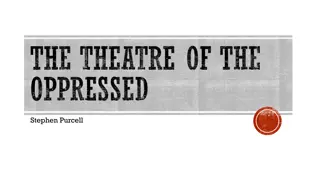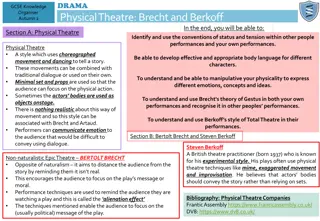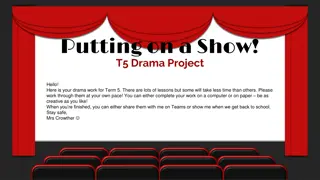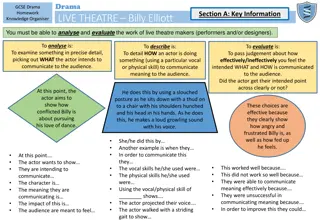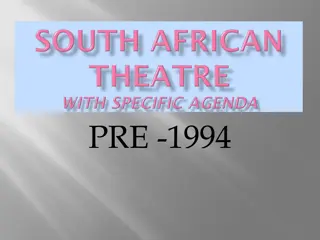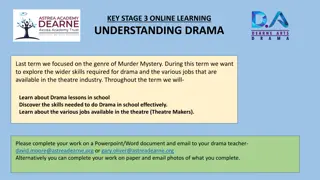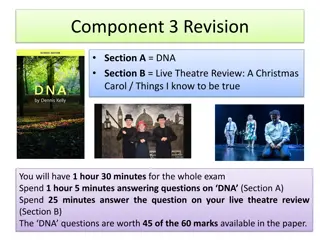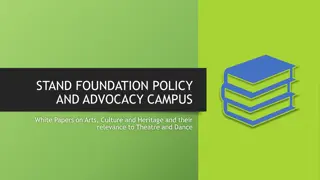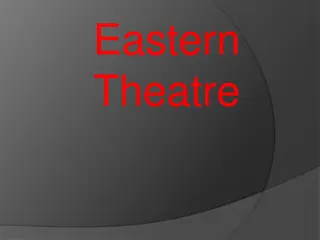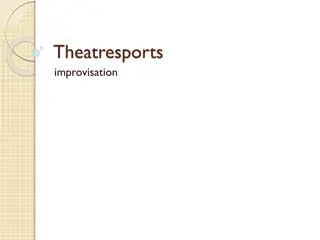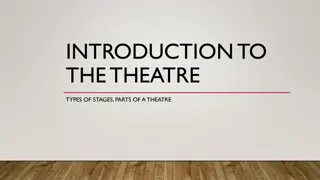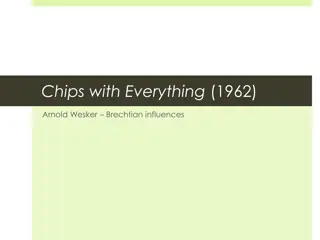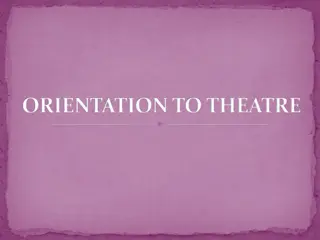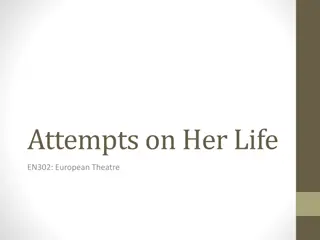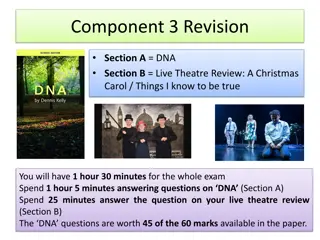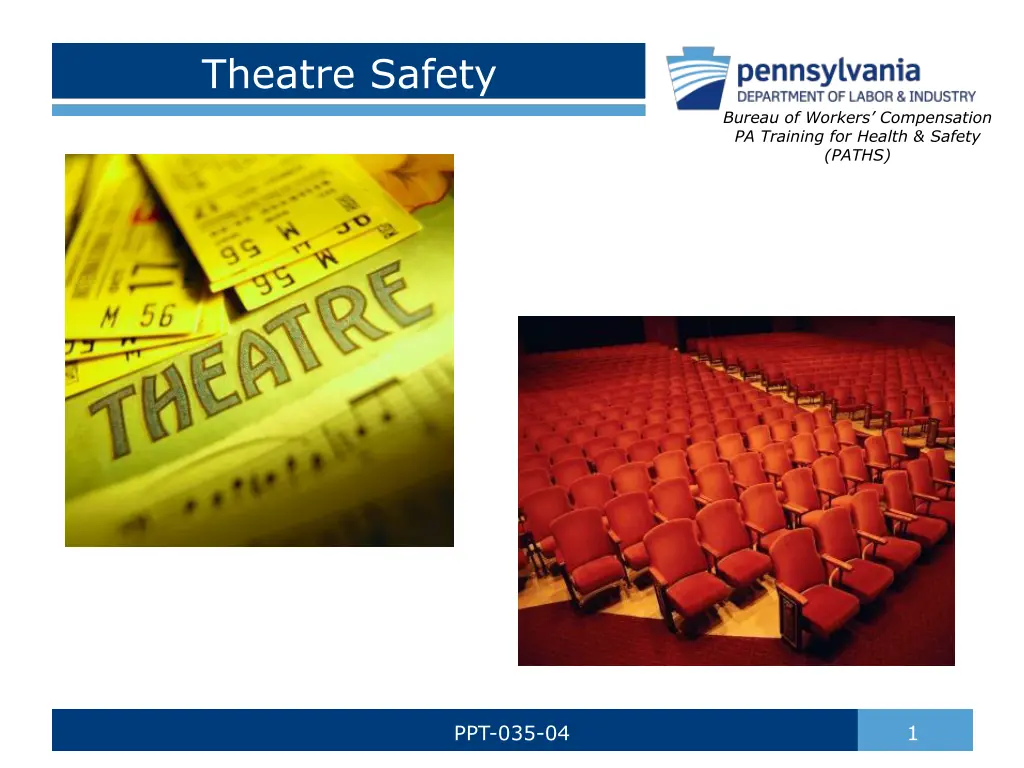
Theatre Safety Training for Workers: Understanding Hazards and Responsibilities
Explore the essential aspects of theatre safety, including basic safety rules, personal safety, emergency plans, and more. Learn about the nature of work in technical theatre and who holds responsibility for safety. Discover the importance of maintenance and set-up safety in performance environments.
Download Presentation

Please find below an Image/Link to download the presentation.
The content on the website is provided AS IS for your information and personal use only. It may not be sold, licensed, or shared on other websites without obtaining consent from the author. If you encounter any issues during the download, it is possible that the publisher has removed the file from their server.
You are allowed to download the files provided on this website for personal or commercial use, subject to the condition that they are used lawfully. All files are the property of their respective owners.
The content on the website is provided AS IS for your information and personal use only. It may not be sold, licensed, or shared on other websites without obtaining consent from the author.
E N D
Presentation Transcript
Theatre Safety Bureau of Workers Compensation PA Training for Health & Safety (PATHS) PPT-035-04 1
What Well Talk About o Basic Safety o Maintenance & Set Up Safety o Personal Safety o Emergency Plan & Fire Safety o Confined Spaces o Chemical Safety PPT-035-04 2
Understanding Your Business o Technical Theatre is hard work and takes effort and training! o Just by the nature of the work there are many hazards present; anyone can be injured if they are not working safely. o Theatre work can be very challenging and stressful, but also fun and rewarding as well! o The teamwork it takes to produce a show must also be used to ensure everyone s safety. PPT-035-04 3
Nature of Work o Basic Stage Safety. o Elevated platforms and workspaces. o Scaffolds and Ladders. o Stage Preparation. o Possibly long hours. o Excessive heat due to lights. o Equipment can be awkward and heavy. o Chemical Safety. PPT-035-04 4
Whos Responsible for Safety? Who s Responsible for YOUR Safety? o First = YOU!!! o Next = Your employer, to provide a safe workplace free from hazards. o Finally = Your fellow employees, to ensure they are working safely. PPT-035-04 5
Basic Safety Rules o Keep mechanical guards in place. o Wear proper clothing and footwear. o Use personal protective equipment (PPE). o No smoking within buildings. o Maintain good housekeeping. PPT-035-04 6
Basic Safety Rules o Keep exits and aisles unobstructed. o No horseplay. o Practice fire prevention. o Maintain proper storage. PPT-035-04 7
Job Related Safety Rules TWO KINDS: Maintenance Set up PERFORMANCE: Sometimes total compliance with OSHA standards may be difficult to achieve during performances (due to effects desired) Safety should always be the #1 priority! PPT-035-04 8
Maintenance & Set-up Safety Fly rail, batten & arbor weighting and rigging: o Don t load or unload pipes until given okay. o Heads up call falling objects, flying battens. o Know who you are answering to (e.g. Master Carpenter, Master Electrician, Master Fly). o Be alert, pay attention! Heads Up! PPT-035-04 9
Rigging Safety Fly or rigging system: allows safe support and quick change scenery and lighting used in theatres Today the main system is rarely a rope system; but often included auxiliary system. Used for temporary or custom rigging; rope systems easier to adapt than counterweight or winch systems. Well equipped theatre, often a flyrail on both stage left and right. PPT-035-04 10
Rigging Safety Counterweights are usually iron or steel, cast or flame cut from heavy plate. o Counterweights are often referred to as "bricks" or as "pigs" (for pig irons). o Come in semi-standard sizes, e.g. 10, 20, 30, and 50 lbs. o Cast weights usually made to an actual weight. o Cut weights may be uneven size, such as 26 or 38 lb. PPT-035-04 11
Rigging Safety Proper procedure for loading battens should ALWAYS be followed when remotely possible. o Send loading crew to loading gallery (rail). o Flyman calls "Heads Up" loudly and lowers empty batten to floor. o Flyman gives clearance to deck crew to hang load on batten. o Crew loads the batten. o AFTER load is on batten, flyman estimates weight and calls up command to the loading gallery to load the arbor with appropriate weights to equal the load. o Loaders raise and secure locknuts and spreader plates, leaving one plate on top of the batten weight, and add the required number of bricks. o If many bricks are needed, another spreader plate should be slid down between the bricks about every two feet or so. PPT-035-04 12
Rigging Safety o When weights are on, loaders slide down remaining plates and lower and lock off lock nuts, and call down that the arbor is locked and secured. o Flyman calls to deck to "Clear the batten", then carefully unlocks rope and tries to fly goods to see if it is heavy or light. o If weights are off, flyman calls corrections up to the loading rail, who follow above procedure to adjust weight to suit. o Once weight is correct, flyman calls "clear the batten" and flies batten out to trim, locking ropelock and securing handle with keeper ring. PPT-035-04 13
Rigging Safety To unload, reverse the procedure: o Bring in batten, unload counterweights to batten weight, THEN unload the goods from the batten. o Always call "Heads Up" when flying things in and "Clear" when flying things out. PPT-035-04 14
Maintenance & Set Up Safety Electricity and Lighting Equipment: o Only use properly grounded tools. o Only use electrical cords in good condition. o Do not overload extension cords or circuits overloading is a hazard! o Inspect all electrical equipment and cords to ensure they are not damaged. o Wait until lamps cool; unplug them prior to changing. PPT-035-04 15
Any Safety Issues? Extension cord plugged into tap possible overload Cords across walkway PPT-035-04 16
Maintenance & Set Up Safety Low light levels, noise levels, obstructions: o Use caution in low light situations. o Use a flashlight when necessary. o Wear appropriate hearing protection. o Do not block aisles, hallways, fire exits, doorways, fire extinguishers, or electrical panels. PPT-035-04 17
Safe Situation? NO! Storage in Mechanical Room not allowed; also, items against electrical panels PPT-035-04 18
Maintenance & Set Up Safety Ladders & Personnel Lifts: o Inspect ladders for defects/damage before using; remove it from service if defects/damage. o Always face a ladder when climbing up or down and maintain 3 points of contact. o Only one person on a ladder at a time. o Ensure personnel lifts are on level/even ground before raising; ensure outriggers are in place. o Do not stand on the railings of the lift to do work PPT-035-04 19
Maintenance & Set Up Safety Ladders & Personnel Lifts: o Do not stand on the top rung/step of ladder. o Do not lean or overreach while on a ladder or in a personnel lift. o Make sure the ladder is firmly in place before climbing. o Never move a ladder or lift while someone is on it. Employee is maintaining three points of contact while working PPT-035-04 20
See Any Problems? Ladder bent, damaged PPT-035-04 21
What About Here? Pin Loose- Coming Out PPT-035-04 22
And This? Man standing on bucket on top step of ladder Other man holding bucket and standing on two step ladders Is this an accident waiting to happen? PPT-035-04 23
Personal Safety o Lift an object using your legs, not your back. o Squat to pick something up, don t bend at waist. o Avoid reaching forward over a long distance. o Avoid bending backward to reach for something. o Clean up spilled liquids immediately. o Do not use a tool/equipment unless you ve been trained on its proper operation. PPT-035-04 24
Personal Safety o Avoid wearing loose fitting clothing that may get caught in moving parts of machinery/equipment. o Wrist watches, rings, and necklaces should not be worn while operating power tools/machinery. o Long hair should be tied back when operating power tools/machinery. o Wear appropriate footwear when cutting, using power tools, lifting, etc. o Never leave machinery running when it is unattended. o Use the proper tool for the job/task. PPT-035-04 25
Which is Safer for Work? These shoes are much safer! PPT-035-04 26
Personal Safety o Avoid running electrical or other cords across walkways if unavoidable, tape down or place in a rubber or plastic channel. o Inspect hand tools before using to ensure they are not defective/damaged. o Inspect ropes/cables to ensure they are not frayed or otherwise damaged. o Use handrails while going up/down stairs. PPT-035-04 27
Would You Use This Tool? Hopefully not! Handle unsafe, needs to be replaced. PPT-035-04 28
Pay Attention to Signs! PPT-035-04 29
Show & Performance Safety o SAFETY FIRST ALWAYS! o Ensure appropriate lighting is in place to prevent accidents. o Never turn off or dim exit signs, stair lights, or hall lights. o Ensure fire protection equipment is not compromised. o At no time should a fire exit be obstructed, blocked, or locked! PPT-035-04 30
Whats the Hazard? Chair & trash can obstruct exit access. PPT-035-04 31
Safety Concerns? PPT-035-04 32
Emergency Plan o Know where first aid kits are located. o Know the location of the nearest Automated External Defibrillator - AED (if available). o Know who to contact during an emergency (911, on-site Security/Police, etc.). o Know what actions to take during an emergency. o Know where exits are located. PPT-035-04 33
Emergency Plan o Know the locations of fire alarm pull boxes and fire extinguishers and how to use them. o Know where safe areas are located to direct audience or crews during an emergency. o Know your designated meeting place after evacuation. o Know the local forecast and be alert for drastic changes in weather. PPT-035-04 34
Fire Safety Basic elements necessary for combustion remove one and fire eventually goes out. PPT-035-04 35
Fire Safety Class of fires: Wood, paper, cloth Gasoline, Kerosene Energized electrical equipment Titanium, Aluminum PPT-035-04 36
Portable Extinguisher Picture Labels Class A Class BC Class ABC PPT-035-04 37
Fire Safety Fire Extinguisher Use: P.A.S.S. P = Pull the Pin A = Aim the nozzle-horn at the base of the fire S = Squeeze the handles together S = Sweep the extinguisher from side to side PPT-035-04 38
Confined Spaces A confined space is defined as a space that: o Is large enough and so configured that an employee can bodily enter and perform assigned work; o Has a limited means for entrance and exit; o Is not designed for continuous employee occupancy. PPT-035-04 39
Permit Required Confined Space Is a confined space with one or more of the following characteristics: o Contains or has potential to contain a hazardous atmosphere (i.e. atmosphere that may expose employees to the risk of injury or death, ability to self-rescue, or acute illness). o Contains a material that has the potential for engulfing an entrant. PPT-035-04 40
Permit Required Confined Space o Entrant could become trapped/asphyxiated by inwardly converging walls or a floor that slopes downward and tapers to a smaller cross section. o Contains any other recognized serious safety or health hazard. PPT-035-04 41
Entry of PRCS o ONLY INDIVIDUALS WITH PROPER TRAINING AND PERSONAL PROTECTIVE EQUIPMENT SHOULD ENTER PERMIT REQUIRED CONFINED SPACES! o IF ENTRY IS NECESSARY CONTACT APPROPRIATE DEPARTMENT FOR ASSISTANCE! PPT-035-04 42
Chemical Safety o Hazardous chemical/material = any element, chemical compound or mixture of elements and/or compounds, which can produce adverse effects on humans. o Includes both physical and health hazards. PPT-035-04 43
Chemical Safety o Ensure all hazardous materials (e.g. paints, solvents, epoxy, etc.) are properly labeled and stored. o Choose water or latex based paints, inks, etc. when possible. o Ask vendor for Safety Data Sheet (SDS) for reference. o Ensure lids are securely fastened when product not in use. PPT-035-04 44
Chemical Safety o If solvent must be used, check threshold limit values, evaporation rates, and any other health and safety information on the label when choosing. o Avoid products that create dust or mist such as aerosol and never use them in an enclosed space. o Avoid anything with known cancer-causing chemicals. PPT-035-04 45
On the Job Injuries/Accidents o If you are injured while working you should notify your Supervisor immediately! o Get medical attention (if necessary). o Ensure an appropriate Injury Report is completed. o Report hazards associated with your injury to the appropriate person for correction. PPT-035-04 46
Protect Your Best Asset-YOU! o Be aware of your surroundings. o Good housekeeping is important for preventing accidents. o Replace all tools and supplies after use. o Stretch to limber up before working. PPT-035-04 47
Remember SAFETY IS EVERYBODY S RESPONSIBILITY DON T TAKE SHORTCUTS WHEN IT COMES TO SAFETY WORK SAFELY ALL THE TIME, EVERY TIME PPT-035-04 48
Thank You for Attending! THE END! PPT-035-04 49
Contact Information Health & Safety Training Specialists 1171 South Cameron Street, Room 324 Harrisburg, PA 17104-2501 (717) 772-1635 RA-LI-BWC-PATHS@pa.gov Like us on Facebook! - https://www.facebook.com/BWCPATHS PPT-035-04 50

